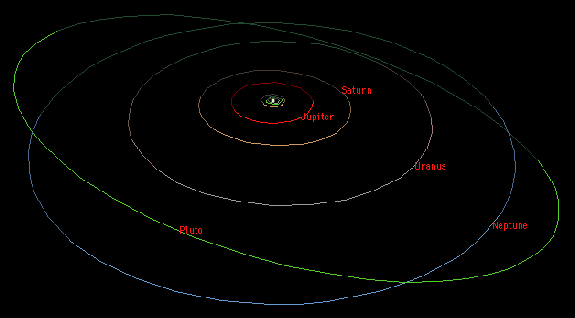MissionHow does DS1's mission compare to other space missions? |
There are several answers to that question.
The first is that space is very, very big. Even the distances between the "inner planets" Mercury, Venus, Earth and Mars boggle the mind. And they are small compared to the distances between planets past Jupiter! Notice the comparatively tiny space that the orbits of the inner planets make up in the picture below.

(Figures represent AVERAGE distance)
| OBJECT | Distance from Sun | Distance from nearest neighbor | Distance from Earth. |
| Sun | 0 miles | 36,800,000 miles (Mercury) | 93,000,000 miles |
| Mercury | 36,800,000 miles | 28,300,000 miles (Venus) | 56,200,000 miles |
| Venus | 65,100,000 miles | 27,900,000 miles (Earth) | 27,900,000 miles |
| Earth | 93,000,000 miles | 27,900,000 miles (Venus) | 0 miles. |
| Mars | 139,500,000 miles | 46,500,000 miles (Earth) | 46,500,000 miles |
| Asteroid Belt | 260,400,000 to 279,000,000 miles | 120,900,000 miles (at the point closest to Mars) | 167,400,000 to 186,000,000 miles |
| Jupiter | 483,600,000 miles | 204,600,000 miles (Asteroid belt at closest point) | 390,600,000 miles |
| Saturn | 883,500,000 miles | 399,900,000 miles (Jupiter) | 790,500,000 miles |
| Uranus | 1,785,600,000 miles | 902,100,000 miles (Saturn) | 1,692,600,000 miles |
| Neptune | 2,790,000,000 miles | 837,000,000 miles (Pluto) | 2,697,000,000 miles |
| Pluto | 3,627,000,000 miles | 837,000,000 miles (Neptune) | 3,534,000,000 miles |
The second is that generally the planets do not circle the Sun at the same rate. That means that their locations do not line up. If you go by the chart above, Saturn and Pluto are 2,743,500,000 miles apart, but that is assuming that they are lined up with each other. If Saturn and Pluto are on opposite sides of the Sun, like they are in the picture above, they are billions of miles further apart!
Another reason space missions take a long time is that we don't have rockets that get us through space very quickly. Generally the amount of thrust, or push, a rocket provides is related to how much fuel it has and how fast the fuel is pushing out of it. Rockets with huge amounts of fuel are too heavy to launch from Earth. That is why the DS1 mission is experimenting with solar ion propulsion, which tries to send small amounts of fuel out very fast, making travel in space faster for the same amount of fuel.
Finally, spacecraft cannot "blast" off of the Earth and go straight towards their destination. The movement of everything in space is influenced by gravity and follows orbits, either around planets, moons or the Sun. In order for DS1 to go to Mars, for example, it must follow an orbit around the Sun widening the orbit like a spiral going outwards until it reaches Mars.

![]()
What is DS1's programmed course?
How does NASA run space missions?
How long will DS1's mission take?
How does a spacecraft get to where its going?
What is gravity?
How do objects in space travel?
What is the difference between an ion engine and a conventional one?
How does solar electric propulsion (ion propulsion) work?
![]()
![]()